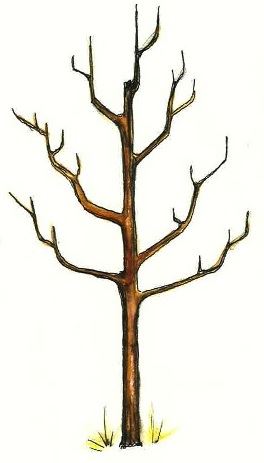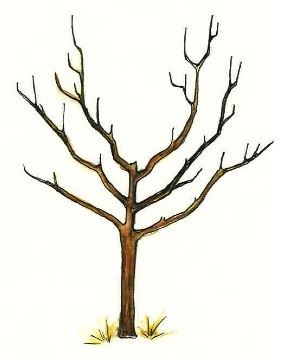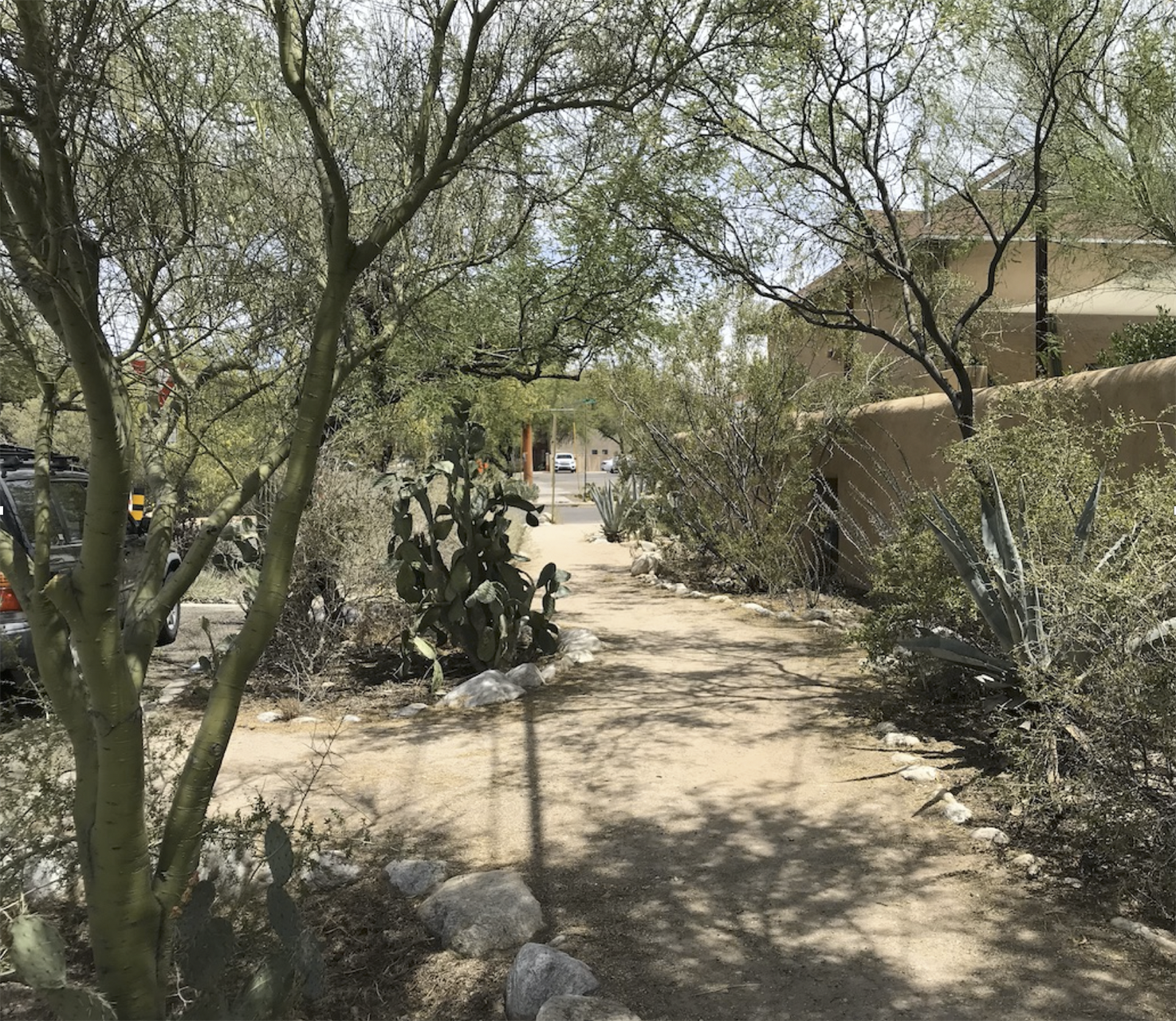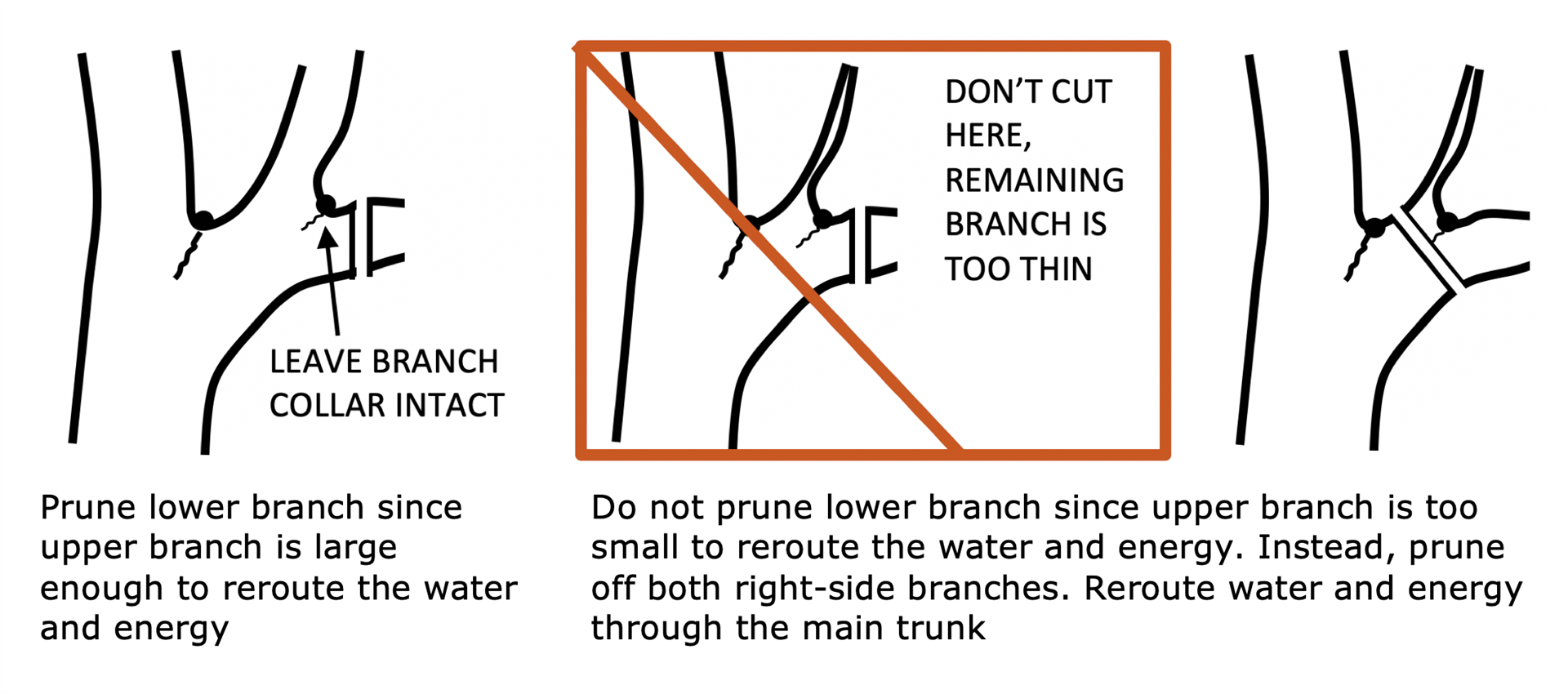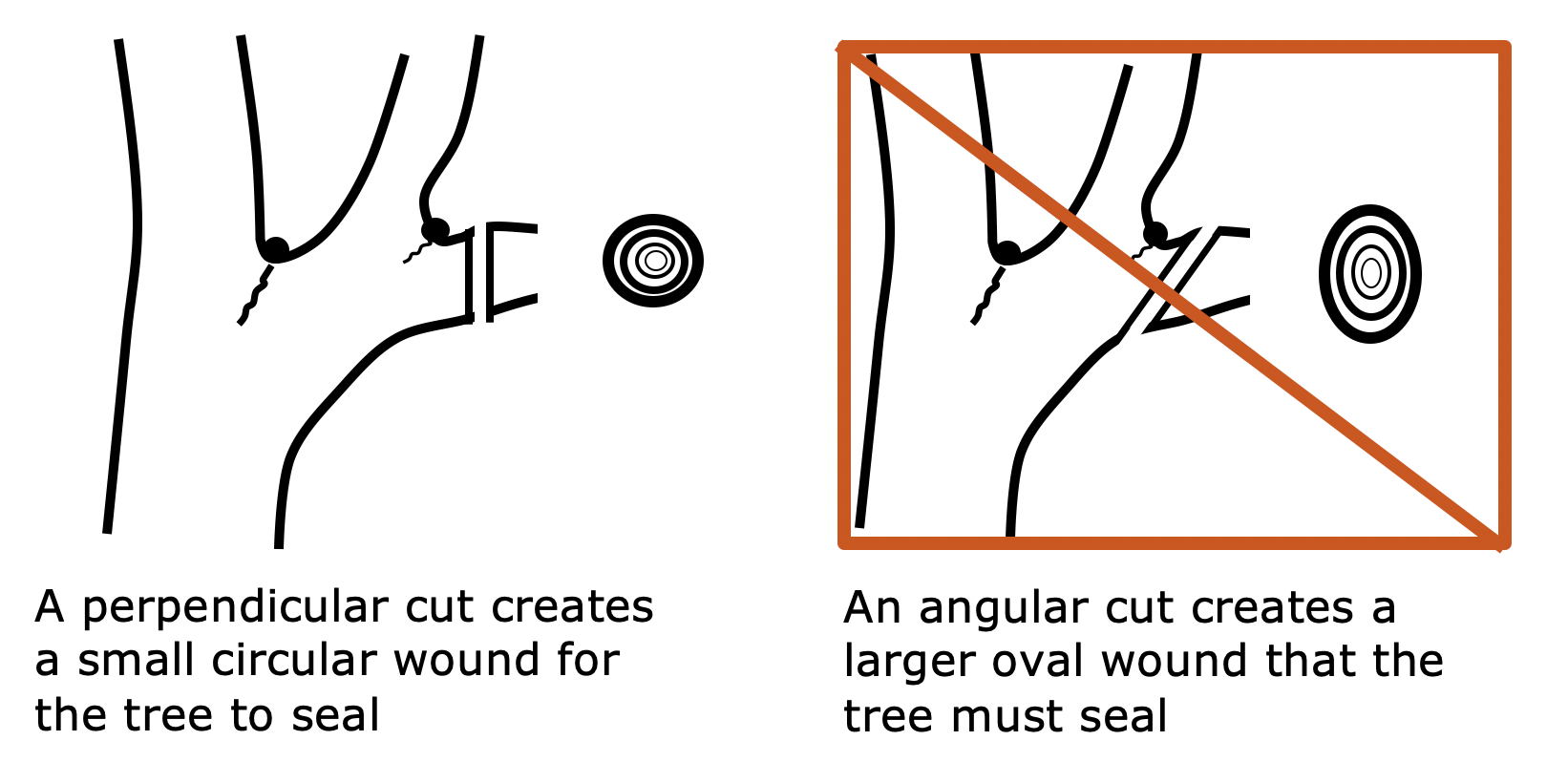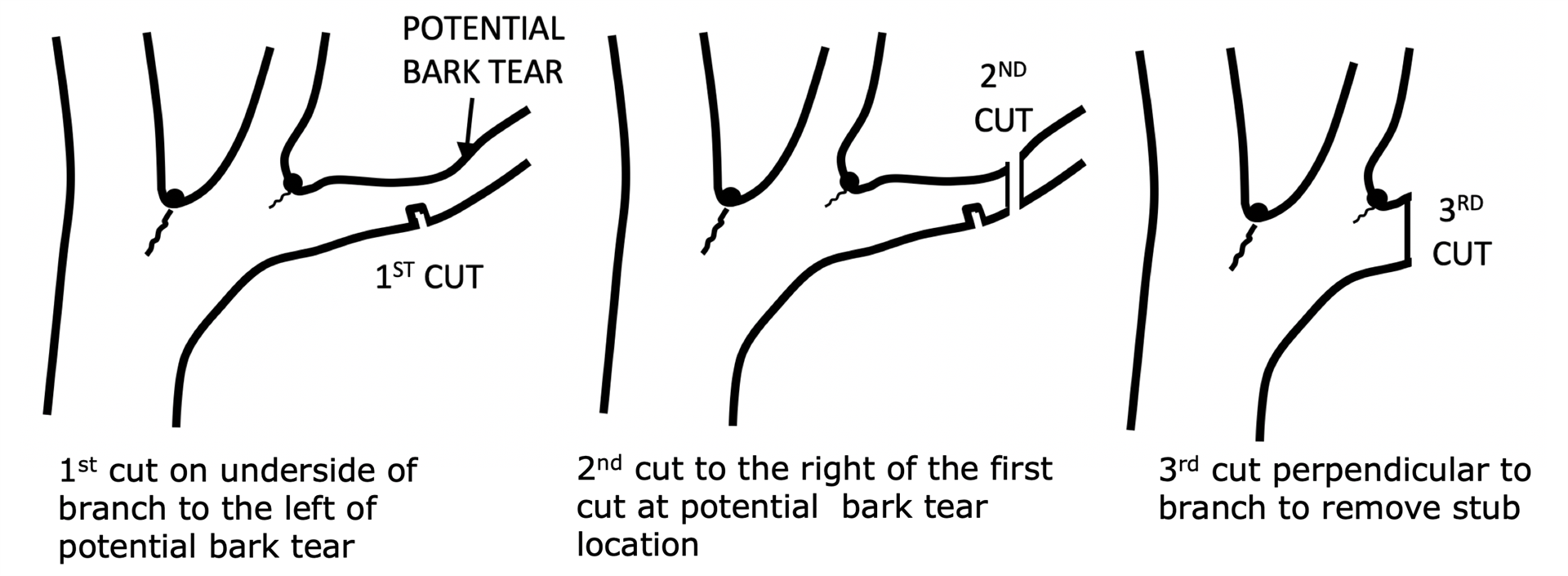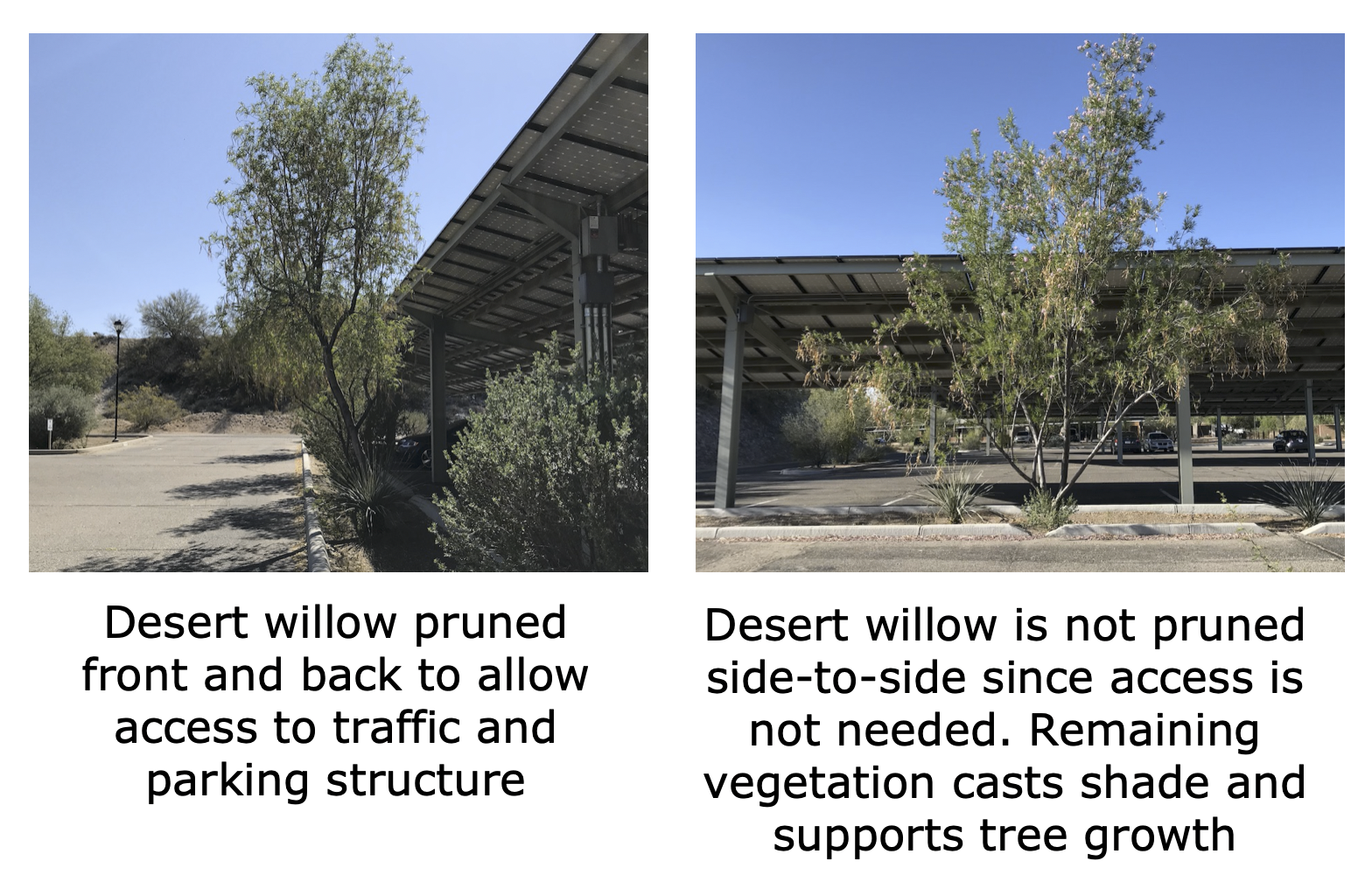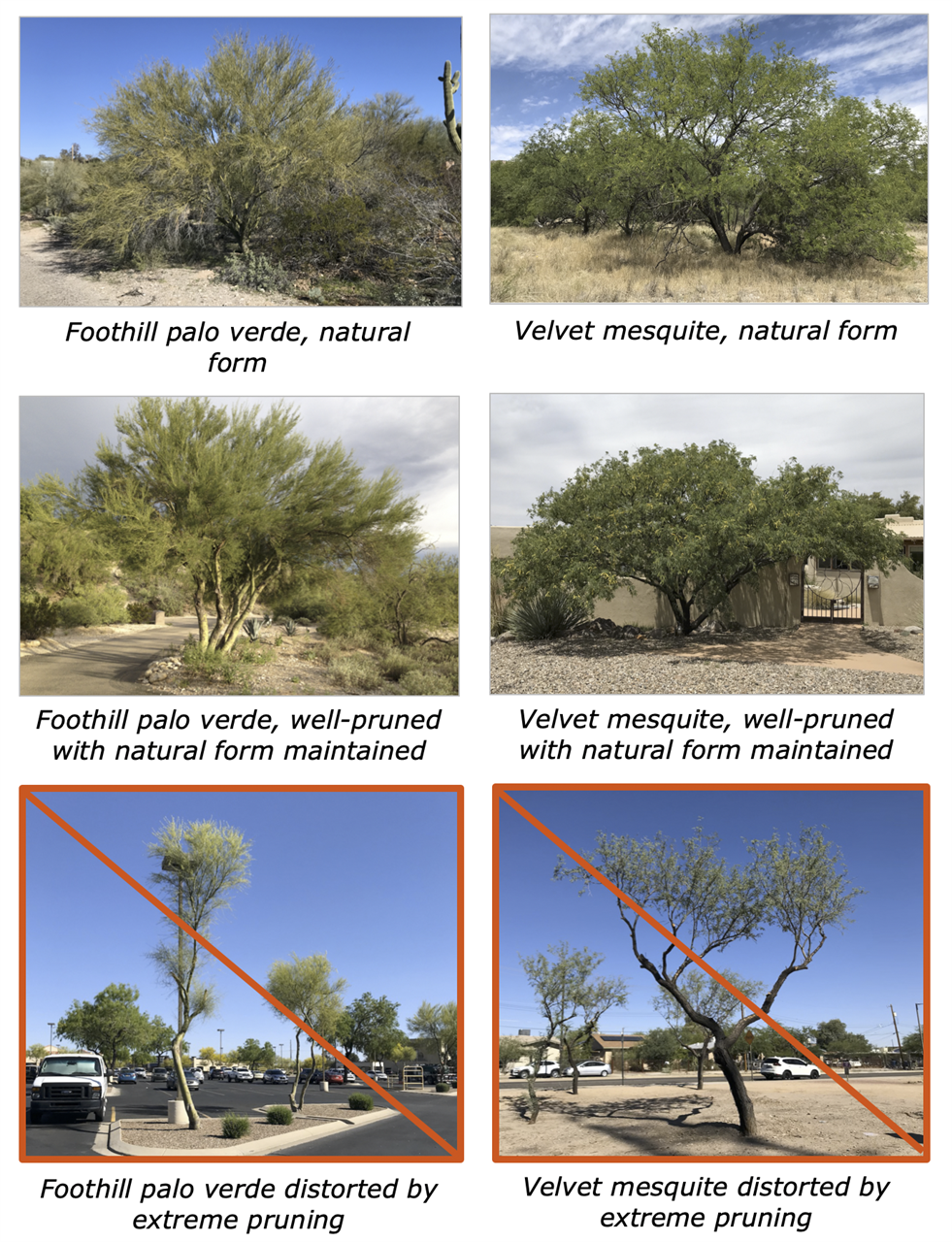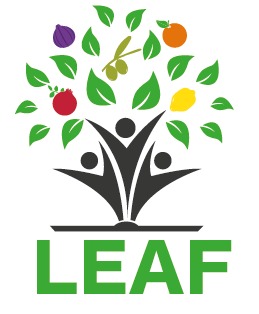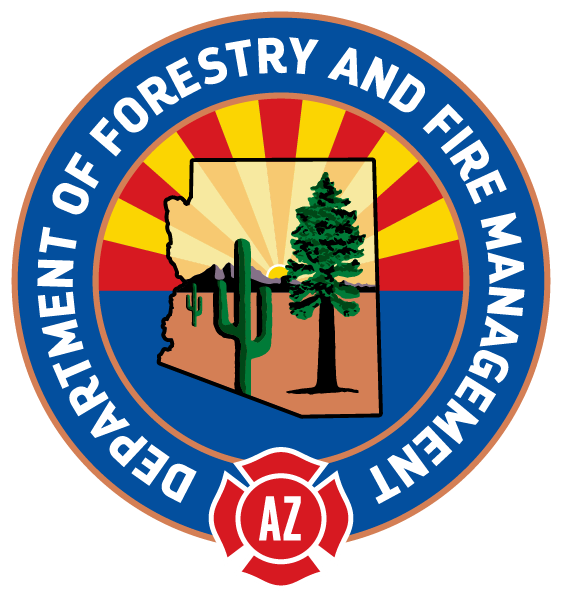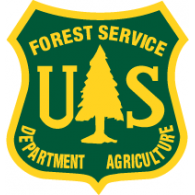Pruning Edible Trees
Click Here for a PDF of Pruning Edible Trees
USE A DIFFERENT APPROACH TO PRUNE FRUIT AND NUT TREES THAN TO PRUNE NATIVE EDIBLE TREES
Nonnative fruit and nut trees are typically single trunked and have been selected for their ability to produce abundant fruit and nut crops. Pruning young fruit and nut trees can promote sturdy branch development, distribute sunlight, create more airspace among the branches, control size and make trees easier to harvest. There are multiple strategies to shaping these trees, as illustrated and described in sections below.
In contrast, most native trees—many of which are multitrunked—do not need extensive pruning. There could be times when pruning is needed to manage access, remove dead branches or address other conditions. When needed, use pruning techniques that are suited for multitrunk trees, as described in later sections.
PROPER PRUNING TOOLS
All pruning tools should be sharp and should be disinfected between use in different trees to reduce the potential to spread any pathogens that might be present. Types of pruning tools include hand pruning shears, lopping shears (loppers) with 24- to 30-inch handles, and pruning saws with 8- to 15-inch curved blade and wide set teeth.
PRUNING FRUIT AND NUT TREES Careful pruning of your fruit and nut trees each year can stimulate growth and fruit production, facilitate care and harvest, and shape the trees for the site. Pruning is most critical just after planting and within the first few years of growth for correct tree structure and to facilitate early fruiting. Annual pruning encourages new, productive fruiting wood and increases fruit yield. On peach trees, for example, the one-year-old wood produces fruit. On other fruit trees, such as apples, pears, cherries and plums, the two- to three-year-old wood produces the best fruit. Overgrown trees can quickly become unproductive, while 70-year-old fruit trees that are pruned annually may still bear fruit. Structural pruning of vertical branches at the tip stimulates development of horizontal branches, which yield more fruit. Additionally, branches with wide angles between the branch and trunk are stronger and will hold more fruit weight. Vertically oriented branches with narrow angles (less the 60°) are weak and break easily. Keeping a well-maintained orchard will enhance its health, productivity and long life. WHY PRUNE FRUIT AND NUT TREES?
HOW TO PRUNE FRUIT AND NUT TREES Three common pruning patterns are described below. Central Leader A tree trained to a central leader takes up less space and can be high yielding, but fruit on high branches may be harder to harvest. To train trees to a central leader, choose a strong, vigorous shoot high on the tree the first winter after planting. Cut off the top inch to stimulate branching. Cut, or head all other vigorous shoots more severely. Repeat the process in the following two seasons so that no side branches compete with the central leader. A tree trained to a central leader will take up less space and be high yielding, though fruit may be produced higher on the tree and more difficult to harvest. Trees that respond best to central leader pruning are apple, pear, persimmon and pecan.
Tree pruned to create central leader Modified Central Leader A modified central leader tree has the central leader pruned back at a reduced height so that the tree develops a wide scaffold, with a balance of vertical and horizontal branches. This stops the upright growth and stimulates growth of side branches. Repeat annually to reduce the vigor of the tree.
Tree pruned to create modified central leader Open Center or Vase Shape A tree pruned to an open center or vase shape has a spreading branch structure that allows for airflow, more sunlight and easy harvesting. All fruit trees can be trained to an open center with judicious pruning. However, the normal growth habits of some kinds of fruit trees allow easier open-center training. Trees that respond best are almond, apricot, cherry, fig, nectarine, olive, peach, pear, persimmon, plum and pomegranate. For an open center or vase shape, choose two, three or four evenly distributed shoots to form primary scaffold branches the first winter. Remove or severely head all others. Choose one or two more the second season. Scaffold branches should be at least 8 inches apart on the trunk for a strong tree structure. Prune interior vertical branches and watersprouts (new vertical growth) each year to allow air and sunlight to reach all branches of the tree. Leave some strong one-year-old wood on the outer branches for future small shoot development. This should be used primarily for stone fruit trees, but can result in sun damage to trees planted in the low desert.
WHEN TO PRUNE FRUIT AND NUT TREES Prune deciduous trees each year in winter or early spring when branches are bare and easy to see, sap is slow, and the wounds have time to seal. If the trees are bare, the structure of the tree is readily identifiable and pruning decisions are easier. Evergreen trees should also be pruned during the winter dormant season, except citrus, which should be pruned in the spring between February and April. There are three stages of pruning during the life of a fruit trees. Pruning at transplanting When trees are just transplanted, remove any shoots below 18 inches on the tree trunk. If the tree is unbranched (whip), the top of the main trunk or leader may be cut off at 30-36 inches tall to stimulate more lateral branch growth. This will remove 1/3 to 1/2 of the tree depending on size. If the tree has branches, select up to four that form wide angles (45° or larger) with the trunk. Select branches that are spaced 4-6 inches apart on the trunk in a spiral arrangement. Prune these back to 1/4 of their length. To train into a central or modified leader shape (see above), prune the top to 12 inches above the top branch. For an open center or vase shape, prune the top to just above the top branch. We always recommend transplanting trees during the dormant season. This gives the tree time to establish before hot weather, and gives pruning cuts time to seal. Training young trees Training fruit and nut trees during the first years of growth can promote desired tree forms and fruiting habits. Shape generally involves three training methods: a) central leader, b) modified leader or c) open or vase shape (see above). Remember that pruning can also damage and weaken young trees so keep severe cuts to a minimum. Choose your pruning cuts carefully and always make them during the dormant season when sap is slow and the wounds have time to seal properly. Pruning mature trees Most fruit trees should be pruned each year in spring. Prune interior branches and new vertical growth to allow air and sun to reach all tree branches. Make clean cuts just past the branch collar at the limb juncture, not leaving large stubs. Leave healthy one-year-old growth on outer branches for future shoot growth and fruit production. To prune mature trees, follow these simple steps:
Other considerations when pruning:
THINNING FRUIT Thinning fruit can increase the overall size and quality of the mature fruit and the vigor of the tree. Carefully thin overly abundant small fruits, damaged fruits or malformed fruits. The timing will depend on the type of fruit trees. When thinning stone fruit, remove immature fruits after flower petals have fallen and as soon as the fruits are large enough to see. Remove any damaged or malformed fruits. Leave fruits spaced about 6-8 inches apart, leaving only two fruits on a shoot. When thinning apples and pears, thin fruit within 30 days after blooming to help reduce the alternate-year bearing that can occur in these trees. Apple blossoms and fruits occur in clusters; leave only the largest fruit in each cluster. Space fruits 6-8 inches apart. | PRUNING NATIVE EDIBLE TREES Native southwest trees that grow in desert areas often have multiple trunks, each contributing foliage to create large, draping canopies that shade both the tree trunk and the soil below. The less you prune native trees, the better off your trees will be. Abundant leaves fuel growth because leaves—along with the green photosynthetic bark on some native trees—convert sunlight to sugar to fuel tree growth. Thicker tree canopies provide deep shade that cools people as well as the tree’s trunk, branches, understory plants, soil, and birds and wildlife who live in or harbor under the tree. In addition, broad canopies deflect strong, drying winds that are common in the southwest. Hormones made in a tree’s branch tips assist in root growth, which creates more drought-tolerant trees that are well anchored to withstand strong winds.
WHY PRUNE NATIVE EDIBLE TREES?
Confirm a branch is brittle before removing it since some trees drop leaves in heat and drought but branches remain pliable and leaves will grow back when water returns. HOW TO PRUNE NATIVE EDIBLE TREES When pruning, determine specific tree-shaping goals you want to meet, then start small, go slow and reassess often. Begin with small branchlets and branches, pruning back to branch junctions from the bottom up and outside in. Step back often to see if remaining branches “lift up,” reducing the need for further pruning. Continue pruning until you meet your specific pruning needs, then leave the rest of the tree intact. Prune only the parts of trees that are dead, damaged or in the way. Wait three years before pruning newly planted native edible trees to allow young branch tips to encourage root growth. Do not prune more than 20 - 25% of a tree at any one time. Pruning more severely reduces the tree's food source. Prune at junctions where branches divide, and where remaining branch is growing up and out. This maintains the flow of water and energy that supports branches and tree. Make sure the branch you leave is at least 1/3rd the diameter of the branch you cut off so it can convey the flow of water from the cut branch up to the remaining branch and leaves. Cut close to branch, leaving branch collar intact.
Make clean straight cuts perpendicular to branches. Use sharp pruning tools to make clean cuts. Make perpendicular cuts that create small circular wounds that the tree can efficiently seal. Do not make angular cuts that create large oval wounds that require more work for the tree to seal.
Use the three-step cut method for larger branches (greater than 5/8 inch diameter). Using the three-step method avoids stripping off bark that creates a larger wound the tree must seal. Use a pruning saw to make the three cuts: - 1st cut: Place the saw under the branch 3 to 5 inches from the branch collar, then cut upwards ¼ of the way into the branch. - 2nd cut: Place the saw on top of the branch to the right of the 1st cut and finish the cut downwards. - 3rd cut: Remove the stub with a perpendicular cut, leaving the branch collar intact.
Do not leave dead-end stubs. If you cut a tree branch in a place that leaves a long branch stub, it’s like cutting a flowing water pipe in its middle—water and energy flowing through the tree branch into the stub have nowhere to go. Instead, at a branch junction, make a perpendicular cut just outside the branch collar of the branch you want to remove. Water and energy are now rerouted to the remaining branch.
After removing what must be pruned to meet your goals, leave the rest of the tree in its natural form. You can prune one side of a native tree and leave the rest of the tree intact. This retains more leaves that cast shade and support tree and root growth.
Leave enough canopy to shade a native edible tree’s remaining trunks and limbs to avoid causing sunburn. Removing large sections of canopy can expose tender bark to intense sunlight, causing sunburn. Palo verde trees are particularly susceptible to sunburn. If possible, prune in late winter to reduce sun damage. DO NOT conduct extreme pruning of native trees because this permanently distorts the trees. Extreme pruning weakens tree health, exposes trunks to harsh sun and heat, starves trees of food and drastically reduces the shade cast by trees. Do not shear the tops or sides of native edible trees because this creates a dense mass of leaves at the ends of cut branches, eliminating light and stressing and weakening the plant’s interior structure.
WHEN TO PRUNE NATIVE EDIBLE TREES Trees do not “heal” wounds, they “seal” wounds, so prune at the right time to help the tree seal pruning wounds. The best time for major, structural pruning is late winter (February) because there is a higher risk of fungal infections early in the winter rainy season. Many native trees are winter deciduous so you can see branches clearly and easily remove mistletoe. At this time of year, plants will soon undertake spring growth to seal wounds. You can prune in other seasons if needed to remove rain-induced growth or obstructions. If you are planning additional pruning, waiting until early summer will incorporate the flush of spring growth. |
CAUTION: Never eat anything that is not properly identified. It is your responsibility to ensure that all fruits, nuts, seeds, pods and other edible products of trees and shrubs are correctly identified and safe to eat before eating them or serving them to others.
Copyright 2023
LEAF is under the fiduciary stewardship of the Arizona Community Tree Council, a 501(c)3 non-profit organization.
70 S Val Vista Drive, Suite A3-186, Gilbert, AZ 85296

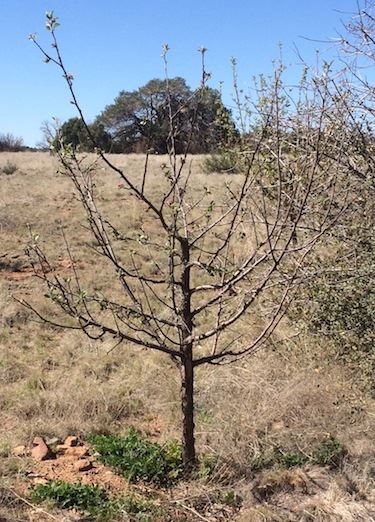 Well pruned young apple tree
Well pruned young apple tree